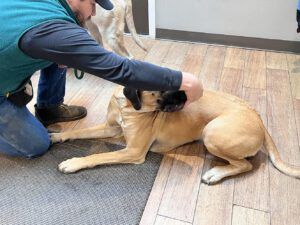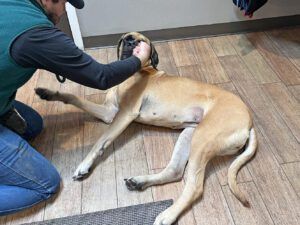If you need more information about Teach Your Dog to Settle and Relax on Cue, you can check the following LINK.
Teaching your dog to exhibit calm, relaxed behaviors on cue can teach him to be genuinely calm.

The behaviors of relaxing and settling on cue are highly appreciated by most dog owners. Whether you’re fixing your dog’s dinner (or yours), greeting guests at the door, sitting in the lobby at your veterinarian’s office, or driving with your dog in the back seat, if your dog will exhibit a calm “Relax” behavior, it can help reduce stress and make everyone’s day smoother.
But your convenience isn’t the only compelling reason to teach these behaviors to your dog. When dogs learn that the act of remaining calm and still earns them treats and praise – when they learn that you will generously reinforce these behaviors – they will offer them more often.
In addition, when our dogs act calm, they will actually become calmer. Gradually, the physiological state of relaxation will develop as a conditioned response to reinforcement for the outward behavior.
Two Very Useful Calming Behaviors
I teach “Settle” and “Relax” as two separate behaviors:
I use the cue “Settle” to mean the behavior of relaxing while lying down on one hip for an extended period of time – several minutes or longer – on a mat or rug.
“Relax” takes the lying-down behavior one calm step further; I teach Relax to mean “lie flat on your side for an extended period of time.” I know a dog has dependably learned this behavior when she falls asleep shortly after being cued and rewarded for relaxing flat on her side!
How to Teach “Settle”
This exercise teaches your dog to lie quietly at your side while you are otherwise engaged. It’s a great behavior to practice while watching television; you’re just hanging out anyway!
- Sit in a chair with your dog next to you and invite her to lie down with a cue for this behavior. (Although it’s preferable if she already understands a cue for Down, if she doesn’t, you can lure her into the Down. (See “How to Teach Your Dog to Lie Down on Cue.”)
- Mark the moment she lies down (click or say “Yes!”) and give her a treat; then, before she has time to get up, quickly mark again and give her another treat. Note: If your marker tends to excite her, you can just feed the treat without marking. Make sure you feed treats directly to her mouth and low to the floor so she doesn’t stand up to reach the treat.
- If she’s not already lying with her weight shifted onto one hip, encourage her to rock onto one hip by moving the treat to the side in a semi-circle toward her ribs.
Do this in small steps (lure-shaping) until she voluntarily rocks onto her hip; if you try to do too much, you risk making her uncomfortable and having her get up. Even worse, you can give her a negative association with the settle process, and then she won’t want to do it at all. For the same reason, do not ever try to physically push her onto her hip.
Many dogs will settle more easily on one side than the other, so if you’re having trouble getting her to do this, try luring her toward the other side. Repeat numerous times.
- When your dog will settle onto one hip easily, say “Settle” just before you lure her onto her hip. Fade the lure (gradually stop using the lure) as soon as she’s easily settling onto one hip. Eventually she will settle when you give the cue, without needing the lure.
- Gradually increase the duration of the relaxed-on-one-hip position by increasing the time between treats so she stays down by her own choice, waiting for the next mark and treat. As you decrease the number of marks, substitute calm praise (with no treats) in between the marks/treats. If your click or verbal marker tends to excite her, switch to praise sooner.
- When your dog will stay down in the Settle position for 20 seconds or more, start using Settle cue without asking her to Down first.
- Continue to decrease your rate of reinforcement (marks and treats) until she can lie quietly at your feet for an extended period with very little reinforcement.
How to Teach “Relax”
You can add Relax to your dog’s repertoire when she does Settle easily and with moderate duration, as this is an even more relaxed position than the rocked-on-one-hip pose.
First, ask your dog to Settle. Then with a treat in your hand, encourage her to roll flat onto one side by moving the lure in a “C” shape toward her ribcage, then up toward her spine. Be sure to roll her in the same direction you already started with the Settle. Again, you will likely need to lure-shape. Many dogs get a little stuck at the point when they actually have to tip over. Be sure to stay within her comfort zone to avoid making her uncomfortable, and again, do not ever try to physically push her onto her side. Add your Relax cue when you can easily lure her onto her side, then work on duration as described in Steps 5, 6, and 7 above.
Use a “Place Mat” for Portable Calm
Make sure to generalize your Settle and Relax cues by practicing these behaviors in a wide variety of different locations.
There is also great value in teaching your dog to settle and/or relax on her own personal “place mat” by practicing the behaviors on an easily portable towel, blanket, or mat that you can transport easily. That way, your dog will develop a strong association with being calm and relaxed on her mat for long periods. Then you can take the mat with you anywhere you go, significantly increasing your likelihood of success with your calm cues when bringing your canine pal with you to dine at an outdoor cafe, watch your child’s baseball game, visit friends, or wait in your vet’s lobby.
-Exercise your dog well, and give her time to calm down before you do a Settle/Relax training session. A tired dog will learn to relax much more easily than one who is cranked and full of energy. Once the behavior is well established, you can use these cues to help a rambunctious dog to calm down.
-Play calming music. Remember that the goal is to give your dog a very calm association with her cues (and her mat), and calming music can help do this. (See “Do Dogs Like Music?” for links to calming music for dogs.)
-Teach your dog to breathe. I know, she already knows how to breathe! Karen Overall, VMD, PhD, a veterinary behaviorist and Diplomate of the American College of Veterinary Behaviorists (DACVB), has a protocol for teaching a dog to take slow, calming breaths (instead of panting), which helps the dog become calm. (For Dr. Overall’s complete protocol, see “Teaching Your Dog Calm, Slow Breathing.”)
Get even more great ideas about Teach Your Dog to Settle and Relax on Cue by visiting our recommendation website with LINK. Thank you for visiting l2sanpiero.com with article Teach Your Dog to Settle and Relax on Cue. Good luck and see you in the next article


